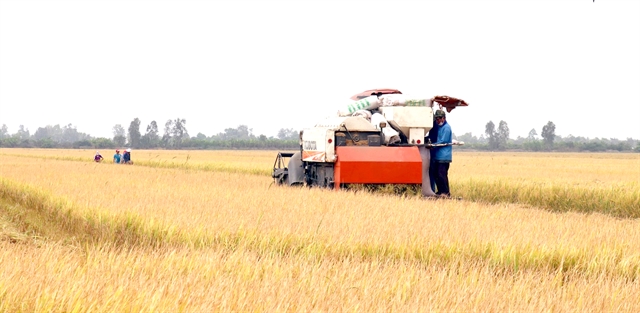 Society
Society

The Cửu Long (Mekong) Delta province of Kiên Giang in recent years has seen a rise in production efficiency after it began rotating rice cultivation and shrimp breeding on the same fields and switching to other crops on unproductive rice fields.

|
| Harvesting the 2020 – 21 winter – spring rice crop in Kiên Giang Province’s Tân Hiệp District. – VNA/VNS Photo Lê Huy Hải |
KIÊN GIANG – The Cửu Long (Mekong) Delta province of Kiên Giang in recent years has seen a rise in production efficiency after it began rotating rice cultivation and shrimp breeding on the same fields and switching to other crops on unproductive rice fields.
The switch was part of the province’s agricultural restructuring plan and Government Resolution 120 issued in 2017, which called for sustainable and climate-resilient development of the delta.
The province, the country’s largest rice producer, made the switch on 32,864ha of rice in the 2017 – 20 period, improving production efficiency and farmers' incomes, according to its Department of Agriculture and Rural Development.
Of that amount, 21,688ha of rice fields that grew two rice crops a year in U Minh Thượng and Long Xuyên Quadrangle areas shifted to growing rice and breeding shrimp on the same rice fields in rotation.
The remaining rice farming areas in Giang Thành, Hòn Đất, U Minh Thượng, Châu Thành districts and Rạch Giá City, which had grown three crops a year, turned to rotating rice and vegetables, or switched completely to growing vegetables and other crops.
During the period, the province also used alum - affected, unproductive rice fields in these same areas to grow fruits, pepper, pineapple and banana.
Quảng Trọng Thao, deputy director of the department, said that advanced techniques and machines have been used to increase yield and quality and reduce production costs.
The province planted 725,863ha of rice with an output of 4.5 million tonnes last year, up 2.2 per cent of the target set for the growing area and up 5 per cent of the target set for output last year.
Last year, the province had 100 large – scale rice fields with a total area of 30,672ha in which farmers had contracts with rice companies that guaranteed outlets.
Under the province’s restructuring plan, Kiên Giang established intensive rice-farming areas that grow three rice crops a year in areas near closed flood – prevention dykes west of the Hậu River and the Long Xuyên Quadrangle.
It has also created new rice varieties that have short – term maturity, are resistant to saltwater and disease, have high yield and quality, and meet export requirements. The new rice varieties include GKG1, GKG9 and GKG35.
Nguyễn Thanh Nhàn, deputy chairman of the province’s People’s Committee, said that farmers have faced saltwater intrusion, drought and disease in recent years.
To cope with the problems, the province has increased cultivation of rice varieties with high yield and quality, and adapted to climate change and natural conditions in each area.
The province will also set up more large- scale rice fields to serve export requirements. Two key agriculture products, rice and seafood, will be the focus of its restructuring plan.
Farmers will also receive vocational training to improve their production techniques and the operation of agricultural co-operatives.
The province had an average crop production value of VNĐ100 million (US$4,300) per hectare and VNĐ130 million ($5,600) per hectare in aquaculture production last year, according to the department.
Aquaculture
Kiên Giang in recent years has developed shrimp breeding suited to different areas under industrial, semi-industrial, advanced extensive farming, or shrimp – rice farming models.
The province harvested more than 264,100 tonnes of seafood last year, up 7.6 per cent against 2019. Of the amount, shrimp accounted for 92,490 tonnes, according to the department.
Thao, deputy director of the department, said the achievement of the province’s aquaculture last year was the successful breeding of white-legged shrimp under two – stage industrial farming.
The two – stage breeding model, which adapts to climate change and produces clean shrimp, requires various ponds for breeding shrimp and treating water.
Shrimp breeding ponds are equipped with oxygenation facilities, anti-sunlight nets, and plastic sheets for covering their beds.
The breeding model has an average yield of 20 – 30 tonnes per hectare, offering high profits for farmers.
The province plans to breed brackish-water shrimp on a total of 136,000ha with an estimated output of 98,000 tonnes this year.
Most of the shrimp farming areas are bred under industrial, semi-industrial, advanced extensive farming and rice-shrimp rotation farming models.
“The breeding of brackish-water shrimp is expected to face challenges like complicated weather, disadvantageous temperatures, salinity and environmental conditions this year,” said Thao.
The impact of the COVID 19 pandemic has also caused difficulty in breeding, trading and processing shrimp for export, so shrimp cultivation must be done in a safe, sustainable and effective manner.
The province’s Fisheries Sub-department has set up shrimp breeding schedules for each area this year and has worked with localities to urge farmers to follow the schedules in order to prevent disease and natural disasters.
The province’s agencies are also carefully inspecting production of shrimp feed and trading of shrimp fry, medicines and other products used for breeding shrimp and treating waste from shrimp cultivation.
Shrimp farmers have been told to apply Vietnamese good agriculture practices (VietGAP) standards and other international standards to meet domestic and export requirements.
Farmers in the province have bred more than 69,700ha of brackish-water shrimp so far this year. No disease outbreak has occurred this year, according to the department. – VNS